PureInsight | January 25, 2024
[PureInsight.org] The Hollywood blockbuster "2012" has aroused people's attention to the end of the world. The Mayan prophecy and everything related to Mayan culture have once again attracted people's enthusiastic attention.
The Mayan civilization was formed around 2500 BC and was mainly distributed in southern Mexico, Guatemala, Brazil, Belize, as well as western Honduras and El Salvador. Among these countries, Mexico, where indigenous people created the remarkable Olmec, Mayan, and Aztec cultures, has formed a unique ancient civilization through the blending of multiple civilizations.
With the invasion of the Spanish in the 15th century, the Mayan civilization suffered a catastrophic disaster. The rebellious Mayans fought a guerrilla war for more than a hundred years until the last Mayan city-state was destroyed in the Spanish firepower in 1697.
The Mayans demonstrated their high civilization in many areas, including astronomy, calendar, mathematics, and art, and were later referred to by Europeans as the "Greeks of America." This has also led modern people to marvel at their achievements. We will focus on several famous Mayan pyramids.
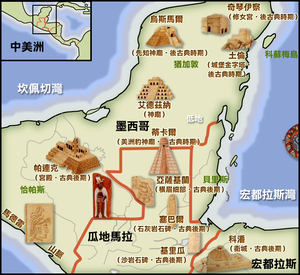
When Italian navigator Columbus set foot on the ancient and mysterious continent of America, he discovered that there were thousands of pyramids hidden in the tropical jungles, as well as cities, temples, and other types of buildings buried in the soil. When Columbus asked the local indigenous people who built these pyramids, no one knew.
The people who lived here built more than 100,000 large and small pyramids from the 7th century BC to the 15th century AD. For more than 500 years, archaeologists have carried out a large number of excavations in America, unearthing a large number of prehistoric cultural relics and revealing the true face of the American pyramids to the world. Some answers have been found through long-term research, but some mysteries still remain unsolved.
In the tropical forests and thickets spanning nearly 350,000 square kilometers of Central America, there are hidden and scattered pyramids that exude a colorful and splendid display of the architectural art of ancient American civilization. Mexico alone has nearly 10,000 pyramids.
Unlike the pyramids of Egypt, the pyramids towering over the Yucatan Peninsula serve not only as the tombs of kings but also as altars.
The astronomical orientation calculations of the Mayan pyramids are more accurate than those of the Egyptian pyramids. For example, the designers and builders of the pyramids can direct the light from Sirius through the air passage on the south wall to shine directly on the head of the pharaoh lying in the upper chamber, while the light from the North Star can be directed through the air passage on the north wall to shine straight into the lower chamber.
Teotihuacan's Sun and Moon pyramids
Teotihuacan, with its city architecture centered around pyramids, is known as the "City of the Gods".
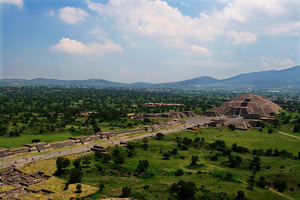
There is a 4-kilometer-long and 45-meter-wide broad avenue running north-south through the city, called the "Avenue of the Dead". When the Aztecs first arrived here in the 10th century, they entered the city along this avenue and found the entire city empty, with the buildings on either side of the avenue being tombs of the gods, hence the name.
At the 1974 International Conference of Americanists held in Mexico, a man named Hugh Harleston claimed to have found a measuring unit that was suitable for all the buildings and streets in Teotihuacan. After computer calculations, the length of the unit was found to be 1.059 meters. For example, the heights of the Feathered Serpent Temple, the Moon Pyramid, and the Sun Pyramid in Teotihuacan are 21, 42, and 63 units respectively, in a ratio of 1:2:3. Harleston used this unit to measure the distances between these ruins on the "Avenue of the Dead", which accurately represent the orbital data of the planets in the solar system.
If everything was just a coincidence, it would be difficult to convince people. It is clear that the "Avenue of the Dead" was built based on a model of the solar system, and the city's designers had an early understanding of the orbital motion between the planets and the sun in the entire solar system. However, humans did not discover Uranus until 1781, Neptune until 1845, and Pluto until 1930. So how could the builders in prehistoric times have known all of this?
The Sun Pyramid and the Moon Pyramid are part of the massive complex at the core of the Teotihuacan archaeological site. The towers are concealed among lush shrubs and bamboo. The local Indians call the two pyramids the "Sun and Moon Pyramids" (Teotihuacan).
Pyramid of the Sun
The "Pyramid of the Sun" is located on the eastern side of the middle section of the "Avenue of the Dead", between the "Pyramid of the Moon" and a small pyramid known as "The Ciudadela," near the Cerro Gordo Mountain. It is the largest structure in the Teotihuacan archaeological site.
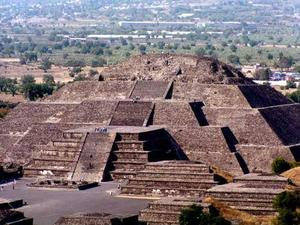
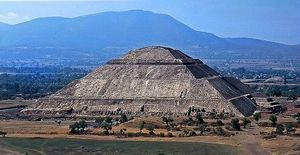
The three pyramids are basically in a straight line, surrounded by many small pyramids and lower buildings, making the central Pyramid of the Sun even more striking and majestic.
The Pyramid of the Sun, built around the 2nd century AD, is trapezoidal in shape, facing east and west, and built inside with 2.5 million tons of soil and sandstone, decorated on the surface with polished smooth huge red volcanic rocks. The base of the pyramid is 700 feet square, 65 meters high, 222 meters long from north to south, and 225 meters wide from east to west, with a total volume of about 1.2 million cubic meters. There are five tiers on the four slopes from the bottom to the top, and 236 steps on the front side. There are stairs leading directly to the top on all four sides of the pyramid, with the widest part of the stairs being 17 meters. The steps are steep, and when looking up from below, they gradually narrow layer by layer, seeming to have no end.
The four sides of the pyramid face the directions of east, south, west, and north, with the sun's rays directly shining on the top of the tower at noon, and the sun setting exactly on its west side in the evening.
At that time, the Teotihuacan people did not have access to iron tools, and the giant stones used to build the pyramid were irregular, mostly in dark brown, yellow-brown, and black colors, giving the entire pyramid a deep and heavy dark tone.
As for the mica sheets from Brazil, which came from two thousand miles away and were hidden between layers of rock in the Pyramid of the Sun, it is still unclear what they were used for.
The surface of the Pyramid of the Sun was previously coated with lime and decorated with bright murals, but after centuries of wind and rain, the murals have mostly peeled off. The original 10-meter-high Sun Temple on the top has been completely destroyed. The ancient Aztecs used it to worship the sun god and called the Pyramid of the Sun the "Temple of the Sun God."
At the north end of the Pyramid of the Sun's plaza, there is a magnificent Sun Palace, which was the palace of the highest priest of the Pyramid of the Sun. The murals inside the palace are brightly colored and one of the most exquisite murals found among the ruins of the ancient city.
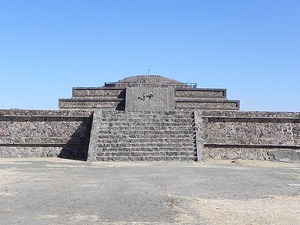
The Ciudadela
In recent years, some astronomers have proposed a new perspective that the orientation of the Pyramid of the Sun and the Pyramid of the Moon has some subtle relationship with the star coordinates of the Milky Way.
The Sun Pyramid is slightly inclined to the northwest of the sunset horizon on April 29th and August 12th. These two days are important for divination and the latter marks the start of the Mayan Long Count calendar. Many important astronomical and astrological events can be observed at the location of the pyramid.
Like the Moon Pyramid, the Sun Pyramid originally had a four-tier structure but was modified during restoration with a new layer added between the original fourth and fifth tiers, making it look incongruous and unrecognizable.
Archaeologists discovered in 1971 that beneath the base of the pyramid was a natural cave leading to underground passages inside the pyramid. The passage is 7 feet high and extends more than 300 feet to the east, reaching the geometric center of the pyramid, which is like a hidden paradise in the shape of a four-leaf clover. Each leaf is a chamber, and many ancient ceremonial artifacts were found in the four chambers, but there were no coffins, just a place for offerings to the gods.
Inside the pyramid, there is a complex drainage system consisting of many interconnected stone pipes.
It is precisely this drainage system that perplexes archaeologists because there is no water source inside the pyramid. However, the complete drainage system indicates that there must have been abundant water flow during the construction of the pyramid. To the north of the Avenue of the Dead, there are several water gates and isolation walls installed along the way, which also indicates that there was once water flowing through this avenue. Alfred E. Schlemmer, an engineering expert specializing in technical predictions, also pointed out the water storage and earthquake prediction functions of this ancient city in his research.
Pyramid of the Moon
The Pyramid of the Moon faces the Pyramid of the Sun from a distance. Its architectural style is similar to that of the Pyramid of the Sun, but it is smaller in scale, less than half its size. Because it is built on a higher base than the Pyramid of the Sun, the heights of the two pyramids' peaks are at the same level.
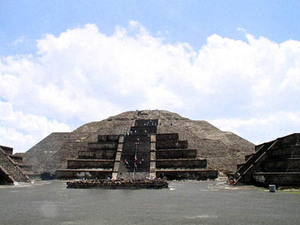
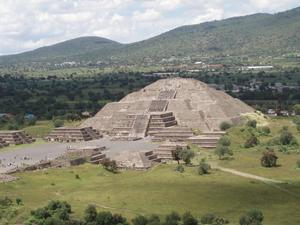
The Pyramid of Moon was built by the ancient Toltec people as a temple to worship the moon god. It was built about 200 years later than the Pyramid of Sun and faces north while the latter faces west. The Pyramid of Moon has a volume of 380,000 cubic meters and a height of only 46 meters, with four layers of pyramids. The over 200 steps on the staircase leading to the top have varying angles of inclination. The external stone blocks are decorated with colorful snakeheads with feather collars and murals symbolizing the rain god made of corn cobs. The Pyramid of Moon plaza measures 204.5 meters from south to north and 137 meters from east to west, with a wide open space capable of accommodating tens of thousands of people. In the center of the plaza stands a square altar. The Pyramid of Moon and its plaza were built symmetrically and have an impressive grandeur. Important religious ceremonies of the ancient city of Teotihuacan were held here.
The Moon Pyramid is composed of approximately one million tons of mud and stone, and when combined with the Pyramid of Sun, the two pyramids weigh a total of 3.5 million tons. Scholars estimate that at least 15,000 workers worked continuously for 30 years to complete the construction of these massive structures.
Scientists in Mexico attempted to use the most advanced muon detectors to capture an X-ray view of the interior of the Teotihuacan Pyramid of Sun to solve the mysteries of the millennium. However, the superb murals, carvings, and painted ceramics at the Teotihuacan site are still treasures of ancient Mexican indigenous culture.
Palenque: Temple of the Inscriptions Pyramid
Palenque, located in southern Mexico near the border of Guatemala, was a thriving city prior to the 9th century. It is said that there were 500 buildings in the Palenque ruins, but only 34 have been excavated so far.
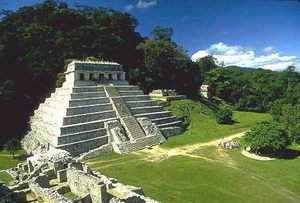
The Temple of the Inscriptions in Palenque is a 10-level pyramid, with each level connected by a staircase made of stone. The bottom level has nine steps, while the others have seven. At the top of the pyramid is a platform with the Temple of the Inscriptions, a place of worship for the gods. The walls of the temple are carved with hieroglyphics, and the corridors are adorned with intricate reliefs and paintings. In the center of the main hall is a spiral-shaped stone platform that leads to the bottom of the pyramid.
In 1952, Mexican archaeologists discovered the tomb of the ancient Palenque king, Pakal, inside the pyramid. The burial chamber was supported by six stone beams and was the first discovered tomb inside an American pyramid, enriching our knowledge of the pyramids in the Americas.
In the center of the burial chamber was a 3-meter-long and 2-meter-wide sarcophagus made of a single massive stone. A 5-ton stone lid covered the sarcophagus, with beautiful patterns carved into its smooth and hard surface. Nine deity figures guard the sarcophagus on the walls of the chamber.
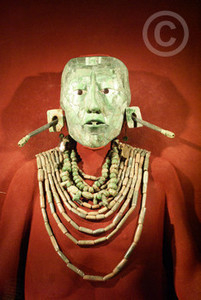
Opening the stone coffin, the body of King Pakal lay inside, wearing a finely crafted jade mask on his face. In each hand, he held a jade bead, and there was another in his mouth, symbolizing resurrection. The body was dressed in luxurious clothing and adorned with jewelry such as necklaces, beads, and rings made of jade.
In the tomb chamber, there was also a gorgeously carved limestone slab measuring approximately 3.65 meters in length, 2.13 meters in width, 30 centimeters in thickness, and weighing 5 tons. After deciphering the inscriptions on the slab, it was discovered that the pyramid originally contained the remains of King Pakal, who was 1.8 meters tall, male, and died in the year 750 AD, which was the peak of the Maya civilization.
According to Mexican archaeologists, the Pyramid of the Inscriptions was started soon after the birth of King Pacal and took decades to construct, requiring a vast amount of manpower and resources. It is evident that this pyramid was one of the representative ceremonial centers of the Mayan classical period and a precious relic of Latin American royal tombs.
What were the game rules of the Maya inside the pyramid? Was it a digital game?
The 69 steps outside the pyramid and the 620 inscriptions in the temple also imply the Mayan 260-day astronomical calendar. Does the sum of these two numbers (620-260=360) also relate to the basic number of the Mayan calendar system, 360?
The first level of the staircase inside the tomb has 26 steps, while the second level has 22 steps, plus the 4 inside the tomb (22+4=26), which all represent the 26-day rotation period of the sun's equatorial magnetic field.
The middle layer of the king's necklace has 37 beads, representing the rotational period of the sun's polar magnetic field during the day.
...
The Maya people used a series of numbers to encode their knowledge of the sun and mysterious information, hiding it within their architecture.
To be continued.
Chinese version: https://big5.zhengjian.org/node/75986
